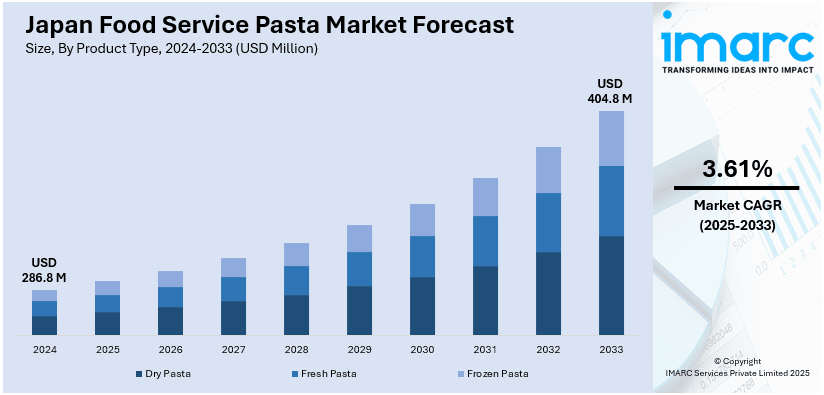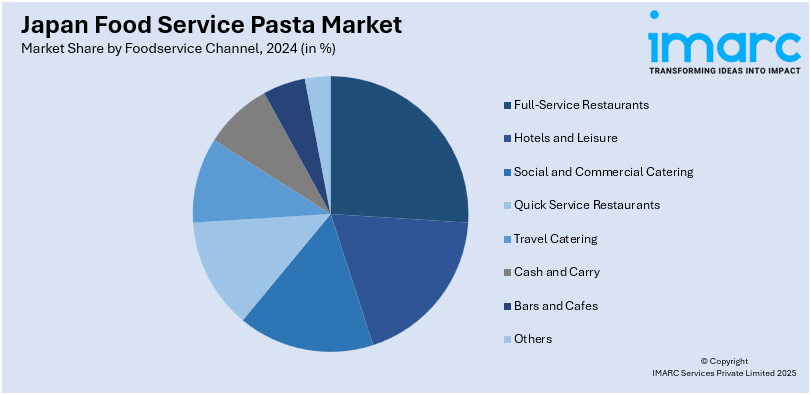
Japan Food Service Pasta Market Size, Share, Trends and Forecast by Product Type, Foodservice Channel, and Region, 2025-2033
Japan Food Service Pasta Market Overview:
The Japan food service pasta market size reached USD 286.8 Million in 2024. Looking forward, IMARC Group expects the market to reach USD 404.8 Million by 2033, exhibiting a growth rate (CAGR) of 3.61% during 2025-2033. Rising demand for convenient and premium dining options, increasing popularity of Italian-Japanese fusion cuisine, growth of quick service restaurants (QSRs), evolving consumer lifestyles, and health-conscious menu innovations are expanding the Japan food service pasta market share.
|
Report Attribute
|
Key Statistics
|
|---|---|
|
Base Year
|
2024 |
|
Forecast Years
|
2025-2033
|
|
Historical Years
|
2019-2024
|
| Market Size in 2024 | USD 286.8 Million |
| Market Forecast in 2033 | USD 404.8 Million |
| Market Growth Rate 2025-2033 | 3.61% |
Japan Food Service Pasta Market Trends:
Rising Popularity of Italian-Japanese Fusion in Foodservice Pasta
Japan’s culinary landscape is increasingly embracing Italian-Japanese fusion, particularly in the food service pasta sector. Notably, a 2025 published article on Tokyo's growing Italian-Japanese fusion cuisine, showcased restaurants like Alter Ego, which debuted in 2019 and has revolutionized fine dining by fusing Japanese and Italian flavors. Originating in the "bubble economy" of the 1980s, this culinary trend has developed into elegant dishes served at restaurants with Michelin stars, such as Gucci Osteria and Peace. Furthermore, pizzerias all across Tokyo are embracing this combination, demonstrating the city's inventive and varied culinary scene. This trend is driven by evolving consumer tastes that seek global flavors with local familiarity. Restaurants and cafés are innovating with pasta dishes like “Mentaiko Spaghetti” (spaghetti with spicy cod roe) or “Shoyu Butter Pasta” that blend traditional Japanese ingredients with Italian techniques. These fusion dishes cater to Japan’s palate while adding a gourmet twist, appealing to millennials and Gen Z diners. Furthermore, foodservice providers are also capitalizing on seasonal ingredients such as yuzu, shiso, and miso to create regionally inspired pasta offerings. This not only increases customer engagement but also supports local agriculture. The trend is especially visible in full-service restaurants and quick-service eateries that want to differentiate themselves in a competitive market. With continued innovation and high customer interest, the Italian Japanese fusion pasta trend is set to remain a strong driver for Japan food service pasta market growth.

Health-Conscious Consumers Fuel Demand for Premium and Whole-Grain Pasta
The growing health consciousness among Japanese consumers is reshaping the food service pasta market, with a noticeable shift towards premium, low-calorie, and whole-grain options. Foodservice operators, especially in hotels, cafes, and upscale restaurants, are introducing pasta varieties made from quinoa, brown rice, and legumes to appeal to health-focused diners. Gluten-free and high-fiber pasta options are becoming mainstream, driven by dietary awareness and increased demand for sustainable nutrition. For instance, Wayback Burgers Asia opened "Next Restaurant," a multi-brand plant-based restaurant, in Omotesando, Tokyo, on October 9, 2024. This cutting-edge restaurant serves a range of vegan and gluten-free alternatives, like as pizzas, pasta dishes, bento boxes, and smoothies prepared with ingredients from Hokkaido's Niseko farms. Moreover, various plant-based restaurants have started adopting pasta sauces—like those using soy milk or tofu, aligning with Japan’s growing flexitarian movement. This trend is amplified by the country’s aging population, which values meals that are both tasty and beneficial for health. By offering pasta that is light, nutritious, and still indulgent, foodservice establishments are able to retain traditional pasta lovers while attracting a new demographic of wellness-minded consumers, which in turn is positively impacting Japan food service pasta market outlook. This health-driven innovation is expected to significantly influence menu planning and supplier choices in the coming years.
Japan Food Service Pasta Market Segmentation:
IMARC Group provides an analysis of the key trends in each segment of the market, along with forecasts at the country level for 2025-2033. Our report has categorized the market based on product type, and foodservice channel.
Product Type Insights:
- Dry Pasta
- Fresh Pasta
- Frozen Pasta
- Filled Pasta
- Simple Pasta
- Ready Meal Pasta
The report has provided a detailed breakup and analysis of the market based on the product type. This includes dry pasta, fresh pasta, and frozen pasta (filles pasta, simple pasta, and ready meal pasta).
Foodservice Channel Insights:

- Full-Service Restaurants
- Hotels and Leisure
- Social and Commercial Catering
- Quick Service Restaurants
- Travel Catering
- Cash and Carry
- Bars and Cafes
- Others
A detailed breakup and analysis of the market based on the foodservice channel have also been provided in the report. This includes full-service restaurants, hotels and leisure, social and commercial catering, quick service restaurants (QSRs), travel catering, cash and carry, bars and cafes, and others.
Regional Insights:
- Kanto Region
- Kansai/Kinki Region
- Central/ Chubu Region
- Kyushu-Okinawa Region
- Tohoku Region
- Chugoku Region
- Hokkaido Region
- Shikoku Region
The report has also provided a comprehensive analysis of all the major regional markets, which include Kanto Region, Kansai/Kinki Region, Central/Chubu Region, Kyushu-Okinawa Region, Tohoku Region, Chugoku Region, Hokkaido Region, and Shikoku Region.
Competitive Landscape:
The market research report has also provided a comprehensive analysis of the competitive landscape. Competitive analysis such as market structure, key player positioning, top winning strategies, competitive dashboard, and company evaluation quadrant has been covered in the report. Also, detailed profiles of all major companies have been provided
Japan Food Service Pasta Market Report Coverage:
| Report Features | Details |
|---|---|
| Base Year of the Analysis | 2024 |
| Historical Period | 2019-2024 |
| Forecast Period | 2025-2033 |
| Units | Million USD |
| Scope of the Report |
Exploration of Historical Trends and Market Outlook, Industry Catalysts and Challenges, Segment-Wise Historical and Future Market Assessment:
|
| Product Types Covered |
|
| Foodservices Covered | Full-Service Restaurants, Hotels and Leisure, Social and Commercial Catering, Quick Service Restaurants (QSRs), Travel Catering, Cash and Carry, Bars and Cafes, Others |
| Regions Covered | Kanto Region, Kansai/Kinki Region, Central/ Chubu Region, Kyushu-Okinawa Region, Tohoku Region, Chugoku Region, Hokkaido Region, Shikoku Region |
| Customization Scope | 10% Free Customization |
| Post-Sale Analyst Support | 10-12 Weeks |
| Delivery Format | PDF and Excel through Email (We can also provide the editable version of the report in PPT/Word format on special request) |
Key Questions Answered in This Report:
- How has the Japan food service pasta market performed so far and how will it perform in the coming years?
- What is the breakup of the Japan food service pasta market on the basis of product type?
- What is the breakup of the Japan food service pasta market on the basis of foodservice channel?
- What is the breakup of the Japan food service pasta market on the basis of region?
- What are the various stages in the value chain of the Japan food service pasta market?
- What are the key driving factors and challenges in the Japan food service pasta market?
- What is the structure of the Japan food service pasta market and who are the key players?
- What is the degree of competition in the Japan food service pasta market?
Key Benefits for Stakeholders:
- IMARC’s industry report offers a comprehensive quantitative analysis of various market segments, historical and current market trends, market forecasts, and dynamics of the Japan food service pasta market from 2019-2033.
- The research report provides the latest information on the market drivers, challenges, and opportunities in the Japan food service pasta market.
- Porter's five forces analysis assist stakeholders in assessing the impact of new entrants, competitive rivalry, supplier power, buyer power, and the threat of substitution. It helps stakeholders to analyze the level of competition within the Japan food service pasta industry and its attractiveness.
- Competitive landscape allows stakeholders to understand their competitive environment and provides an insight into the current positions of key players in the market.
Need more help?
- Speak to our experienced analysts for insights on the current market scenarios.
- Include additional segments and countries to customize the report as per your requirement.
- Gain an unparalleled competitive advantage in your domain by understanding how to utilize the report and positively impacting your operations and revenue.
- For further assistance, please connect with our analysts.
 Request Customization
Request Customization
 Speak to an Analyst
Speak to an Analyst
 Request Brochure
Request Brochure
 Inquire Before Buying
Inquire Before Buying




.webp)




.webp)












